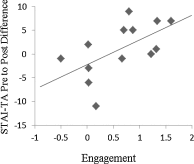Dr Jo Yarker from the Department of Organizational Psychology shares her research into supporting employees who are returning to work following mental ill-health absence.

Around 15% of the working population suffer from common mental disorders (CMDs) such as depression, anxiety and adjustment disorder (OECD, 2014). For half of these, experience of mental ill-health will lead to a period of long-term sickness absence. In the UK alone, stress, anxiety or depression accounts for 57% of all working days lost to ill-health in 2017-2018 (HSE, 2018).
Sustainable return to work for workers with CMDs is therefore a major societal challenge in terms of scale and costs. A successful initial return to work is no guarantee for sustainable return to work, with research suggesting that approximately 19% of workers subsequently relapse and take further absence or exit the workforce (Koopmans, Bültmann, Roelen, Hoedeman, van der Klink, & Groothoff, 2011).
Relapse has significant consequences for sustaining work, with implications for employment prospects, productivity and wages (OECD, 2014). There is an urgent need to better understand how workers with CMDs can be better supported to return to, and stay in, productive work. Together with my colleague Professor Karina Nielsen from the University of Sheffield, I sought to find out how to support employees returning to work following mental ill-health absence.
Understanding the barriers to sustainable return to work
Our study was the first to our knowledge to follow workers post-return using a qualitative approach. We used the recently developed IGLOO framework in our research: examining the Individual, Group, Leader, Organisational and Overarching (IGLOO) contextual factors (Nielsen, Yarker, Munir & Bültmann, 2018) that influence workers with CMDs’ ability to remain in employment throughout working life.

We conducted interviews with 38 workers who had returned from long-term sick leave due to CMDs, the majority of whom we spoke to at multiple points following their return. We’d originally planned to follow workers in the first months after return, however, after being contacted by workers who still experienced challenges long after return, we decided to include these too. We also spoke to twenty line managers with experience managing returning workers.
Our findings
Participants reported a number of resources, in and outside of work, that helped them stay and be productive at work.
Resources at work across the five IGLOO levels help employees stay and be productive at work:
- Individual: Creating structure within their working day to help maintain focus and concentration.
- Group: Gaining feedback on tasks from colleagues, help with challenging tasks and being treated as before, not as someone with a CMD.
- Leader: Agreement of communication to colleagues, continued support and access to work adjustments, and signaling (and being) available but not intrusive.
- Organisational: Flexible working practices and leave policies, accommodating absenteeism policies, work-focused counselling, and demonstrating care through support.
- Overarching context: This level was not applicable as we only examined UK workplaces.
Resources at home across the five IGLOO levels help employees stay and be productive at work:
- Individual: Prioritising self-care and the establishment of clear boundaries between work and leisure.
- Group: Understanding and non-judgmental support from friends and family.
- Links to services: Consistent point of contact and facilitation of links to external services and treatment.
- Organisational: Access to work-focused counselling.
- Overarching context: Those who were financially independent were able to make choices that better suited their needs; the majority reported the positive media attention around mental health enabled them to ask for help.
The main results of our study point to important avenues for future research and practice. Within the workplace, the findings highlight the need to:
- Consider resources at all IGLOO levels and implement multi-level interventions.
- Train returned workers in how to structure their day.
- Train and support line managers, both in having difficult situations but also on how to support workers creating structure and support them manage their workload.
- Develop more information about appropriate work adjustments that can be implemented and how these can be accessed.
- Offer flexibility to the returning employee, in relation to work schedule, ad hoc flexibility when depleted to prevent further decline and aid recovery, and flexibility in tasks.
- Adopt an individual approach as there is no off-shelf-style that works for all.
- Adopt a long term approach, ensuring that employees are able to access adjustments in the months and years that follow.
- Conduct further research to enable us to understand the contribution of these features and their synergistic effect on enabling returned employees to remain productive at work.
Outside the workplace, the findings highlight the need to:
- Conduct further research to better model the impact of support received from friends and family, GP services and those within the voluntary sector.
- Equip GP services with the skills and knowledge to support return to work.
We developed guidance for employees, colleagues, line managers and HR professionals to support returned workers to thrive at work. This and our full report can be found on the Affinity Health at Work website.
Further Information



 Anxiety can be a debilitative emotion that can adversely affect our performance. For example, it is common for individuals with high levels of anxiety to worry excessively about a variety of issues ranging from their performance on upcoming examinations, job interviews, attending meetings, and giving talks to multi-tasking and managing everyday activities efficiently.
Anxiety can be a debilitative emotion that can adversely affect our performance. For example, it is common for individuals with high levels of anxiety to worry excessively about a variety of issues ranging from their performance on upcoming examinations, job interviews, attending meetings, and giving talks to multi-tasking and managing everyday activities efficiently.